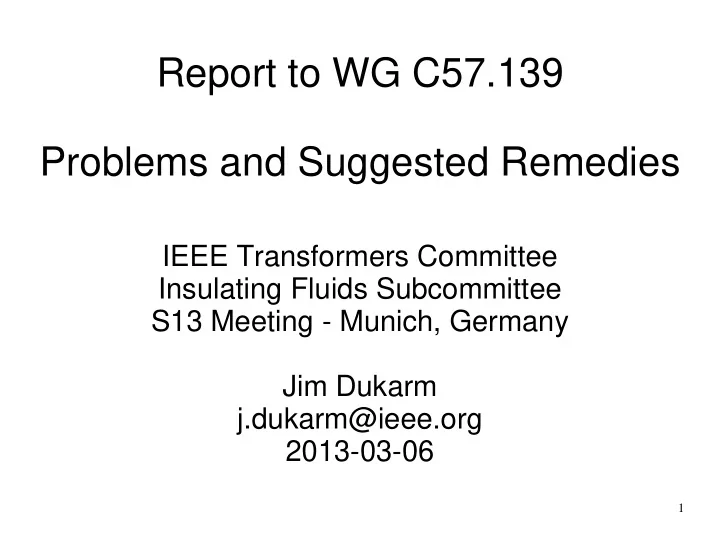

Report to WG C57.139 Problems and Suggested Remedies IEEE Transformers Committee Insulating Fluids Subcommittee S13 Meeting - Munich, Germany Jim Dukarm j.dukarm@ieee.org 2013-03-06 1
Statistical Method Summarized � Use DGA data from 50+ similar LTCs with similar operating conditions and maintenance policies. � Gas concentration and gas ratio limits � Limits are designed to identify data values that are so extreme that they are unlikely to be associated with a trouble-free LTC operating under its usual conditions. 2
Problems with C57.139-2010 Statistical Method � Applicable to populations of 50+ LTCs, but many LTC populations are smaller � Statistical limits for similar LTCs differ greatly between companies. Generic or default limits can't be defined. � When LTCs are new or very well maintained, the statistical limits are often too low to be fault- related. � Not clear how to define limits applicable to exceptional resistive type LTCs. 3
Duval Triangle 2 for LTCs 4
Extra N Zones for Exceptional Types 5
Gas Ratio Limits are Straight Lines A C2H4/C2H2 ratio limit (in this case. 0.42 ) can be represented by a line from the apex to the base. CH4/C2H4 and C2H2/CH4 (or their inverses) are represented by lines from the other corners to the opposite side. Example 3 (Burned Reversing Switch) from C57.139-2010 is plotted as 2 points in N followed by 2 points in T3. Thin line joining them indicates order of occurrence. 6
Proposed Hybrid Approach � Statistical procedure for gas concentration limits modified to work for small (5+) and large LTC populations � Similar modified procedure for gas ratio limits. OR use default limits derived from triangle N zone boundaries. � Use triangle for classifying DGA results as OK or not-OK. Also for detecting and interpreting trends and identifying nature of fault. � Superimpose population-specific ratio limits or an extra N zone, if needed. Default ratio limits can be used for small populations. � Gas concentration limits still needed for some fault types. 7
Recommend
More recommend